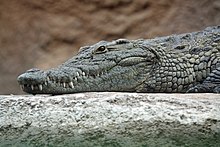
Back Diapsida Afrikaans ثنائيات الأقواس Arabic Diapsida AST Диапсиди Bulgarian ডায়াপসিড Bengali/Bangla Diàpsids Catalan Diapsida CEB Diapsida Czech Diapsida German Diapsidoj Esperanto
| Diapsid reptiles Temporal range: Pennsylvanian–Present,
| |
|---|---|

| |
| Skull diagram of the araeoscelidian Petrolacosaurus kansensis | |

| |
| Nile crocodile (Crocodylus niloticus) | |
| Scientific classification | |
| Domain: | Eukaryota |
| Kingdom: | Animalia |
| Phylum: | Chordata |
| Class: | Reptilia |
| Clade: | Romeriida |
| Clade: | Diapsida Osborn, 1903 |
| Subgroups | |
| |
Diapsids ("two arches") are a clade of sauropsids, distinguished from more primitive eureptiles by the presence of two holes, known as temporal fenestrae, in each side of their skulls. The earliest traditionally identified diapsids, the araeoscelidians, appeared about three hundred million years ago during the late Carboniferous period.[1] All diapsids other than the most primitive ones in the clade Araeoscelidia are often placed into the clade Neodiapsida. The diapsids are extremely diverse, and include birds and all modern reptile groups, including turtles, which were historically thought to lie outside the group.[2] All modern reptiles and birds are placed within the neodiapsid subclade Sauria. Although some diapsids have lost either one hole (lizards), or both holes (snakes and turtles), or have a heavily restructured skull (modern birds), they are still classified as diapsids based on their ancestry. At least 17,084 species of diapsid animals are extant: 9,159 birds,[3] and 7,925 snakes, lizards, tuatara, turtles, and crocodiles.[4]
- ^ "Diapsida". ucmp.berkeley.edu.
- ^ Schoch, Rainer R.; Sues, Hans-Dieter (2016). "The diapsid origin of turtles". Zoology. 119 (3): 159–161. Bibcode:2016Zool..119..159S. doi:10.1016/j.zool.2016.01.004. PMID 26934902.
- ^ Barrowclough, George F.; Cracraft, Joel; Klicka, John; and Zink, Robert M. (23 November 2016). Green, Andy J (ed.). "How Many Kinds of Birds Are There and Why Does It Matter?". PLOS ONE. 11 (11): e0166307. Bibcode:2016PLoSO..1166307B. doi:10.1371/journal.pone.0166307. PMC 5120813. PMID 27880775.
- ^ Reeder, Tod W.; Townsend, Ted M.; Mulcahy, Daniel G.; Noonan, Brice P.; Wood, Perry L. Jr.; Sites, Jack W. Jr.; and Wiens, John J. (2015). Wilf, Peter (ed.). "Integrated Analyses Resolve Conflicts over Squamate Reptile Phylogeny and Reveal Unexpected Placements for Fossil Taxa". PLOS ONE. 10 (3): e0118199. Bibcode:2015PLoSO..1018199R. doi:10.1371/journal.pone.0118199. PMC 4372529. PMID 25803280.